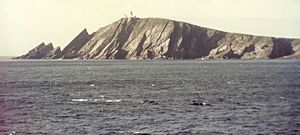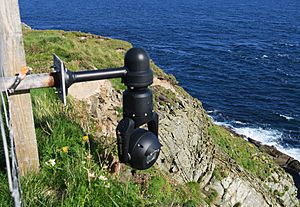Sumburgh Head facts for kids
Sumburgh Head is a famous spot at the very southern tip of the Shetland Mainland in northern Scotland. It's a tall, rocky cliff that rises about 100 meters (328 feet) above the sea. On top of this cliff sits the historic Sumburgh Head Lighthouse. Long ago, the Vikings called this place Dunrøstar høfdi, which means "The Head onto the loud tide-race." This name describes the noisy, fast-moving water known as the Sumburgh Roost that rushes past the headland.
Contents
What Makes Sumburgh Head Special?
Sumburgh Head is not just a pretty view; it's also a very important place for nature and history. It's known for its amazing wildlife, especially seabirds, and its connection to ancient times.
A Home for Wildlife
The cliffs at Sumburgh Head are part of an RSPB nature reserve. This means it's a protected area where birds and other animals can live safely. For a long time, these cliffs were home to huge numbers of seabirds. For example, in the year 2000, there were about 33,000 puffins living here!
However, in recent years, the number of seabirds has dropped quite a lot. By 2017, the puffin population had fallen to only 570. This decline is happening for many types of birds, and scientists are working to understand why. Besides birds, Sumburgh Head has become a popular place to watch for amazing sea creatures like whales and dolphins swimming in the waters below.
The Sumburgh Head Lighthouse
The tall lighthouse you see at Sumburgh Head is a very important landmark. It was designed by a famous engineer named Robert Stevenson. Building the lighthouse started in 1819, and its light first shone brightly in 1821. For over 200 years, this lighthouse has helped guide ships safely past the rocky coast.
Nearby Places to Explore
Right next to Sumburgh Head is Sumburgh Airport, which is the main airport for Shetland. From here, you can catch flights to mainland Scotland, the Orkney Islands, and even Norway.
Just a short distance away, you can find the amazing archaeological site of Jarlshof. This is a place where people have lived for thousands of years! You can see the remains of different settlements built on top of each other, going all the way back to the neolithic period (the New Stone Age). It's like a history book written in stone.
About one mile (2 kilometers) north of Sumburgh Head is a tiny village called Grutness. This is where you can catch the ferry to Fair Isle, a small island known for its birds and unique knitting patterns.



